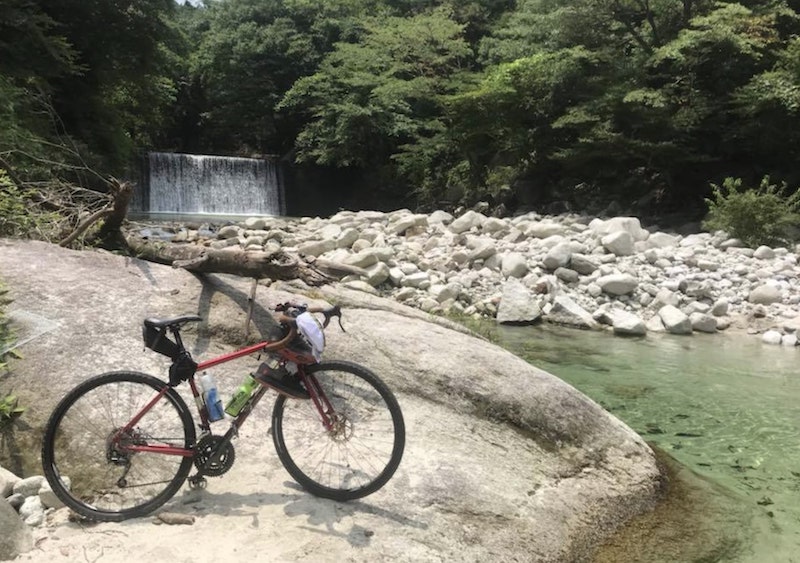May 31, 2022
Get on Your Bike – Cycling in Japan
From May to September, the world’s best cyclists will be putting themselves to the test, competing for the maglia rosa, the malliot jaune and malliot roja in Italy, France and Spain. Seeing the exploits of Mathieu van der Poel, Tadej Pogacar, and Primoz Roglic may put you in mind to get out onto the roads and get some kilometers in the legs, yet traveling to those cycling heartlands is still something of a challenge. But fear not.
Whether you love meandering along coastlines, braving the crosswinds of the countryside, or are a glutton for punishment, crying “shut up legs” as the lactate screams at you in the mountains, Japan is an absolute mecca for cyclists. And best of all, unlike the more popular riding destinations of France, Italy and Spain, there is a greater respect for those of us on two wheels (presumably because everyone’s grandmother gets around on a mamachari) which means it is generally a pretty safe pastime.
There are so many great places to ride, but here is a taste of what you can find out there.
Fuji Five Lakes
What could be a more Japanese experience that cycling around the five lakes region, with Mt Fuji constantly casting its watchful gaze upon you? Nothing, that’s what. The Fuji Five Lakes route is between 110 and 130 kilometers, and you should start out at Kenritsu Fuji-Hokuroku Parking Lot. From there, the route towards Lake Yamanaka will afford you views of Fuji-Q Highland and Kitaguchi Hongu Fuji Sengen-jinja Shrine along the way.

As you go round Yamanakako, you will pass numerous beautiful parks and Mt Fuji observation points before heading towards Lake Kawaguchi, over the lake across the Kawaguchiko Bridge and on to Kawaguchi Sengen Shrine. From there, traverse Kawaguchiko Oishi Park’s Momiji Tunnel – which is especially stunning in autumn – around Lake Kawaguchiko, and then toward Lake Sai, Lake Shoji and Lake Motosu, from where the view of Mt Fuji is at its most glorious. To finish up, it is just a short cruise along the lakeside, back to your starting point.
Shimanamikaido
One of the best known and accessible rides in Japan is the Shiminami Kaido. The world’s second-longest chain of suspension bridges spans the Seto Inland Sea between Imabari in Shikoku and Onomichi in Hiroshima Prefecture, connecting six beautiful islands along the way. The best thing about this bridge system is the cycling paths that provide tourists complete access, except the crossing between Onomichi and Mukaishima Island.

The islands along the 70km trail are picturesque, and intermediate cyclists can cover the route in one day. However, if you want to stop regularly to take in the sights, or if you aren’t a very strong cyclist, it is advisable to give yourself a couple of days to complete the journey.

There are plenty of hotels and ryokans, with all budgets catered for from minshuku inns to top-class accommodation in spa hotels. For stronger riders that want to get more out of their trip, you can extend the ride up to 175 kilometers by taking the long way around the islands.
Shiretoko Loop
The northeastern area of Hokkaido is home to some of Japan’s most spectacular scenery, making it ideal for cycling. There are absolutely loads of great rides on Japan’s most northern island, but the Shiretoko loop is up there with the best. Though, at 350 kilometers and over 4000 meters of climbing, it is not one for casual cyclists.

Starting out at Abashiri, riding east will take you along dramatic coastal roads, with scenes of wildflower-covered sand dunes, up into the Shiretoro National Park.

Keep an eye out for wild deer, and then as you climb up into Shiretoko Pass the views are nothing short of spectacular, with Russia in the distance, and the majestic mountains all around. Pass by Lake Mashu and Lake Kussharo, and make your way back up to Abashiri exhausted but spellbound
Shikoku Pilgrimage
The Shikoku Pilgrimage is a circle of 88 shrines associated with the Buddhist monk Kūkai, that runs around the island prefecture. For centuries pilgrims, or henro, have travelled this route to visit all of them. However, it’s a lot quicker to do this on two wheels than on foot. That said, with about 1200 kilometers in all, it is a pretty decent trip.

But if you have the time – or want to do a bit of the trip, it is well worth it, as Shikoku is an area of absolutely outstanding beauty.

Some of the roads can be a bit challenging as they can go off road, and be sure to plan your trip in advance so that you can be certain of accommodation.
Image by Ryoichi Tanaka via flickr.com [CC By 2.0]
Hiroaki Kaneko, CC BY-SA 3.0, via Wikimedia Commons
Image by Sei F via flickr.com [CC By 2.0]
Image by Simon Desmarais via flickr.com [CC By 2.0]
Image by via flickr.com [CC By 2.0]
Image via https://ridewithgps.com/routes/14122952
Image via https://cycling-island-shikoku.com/en/images/map_large_en.png


About the author